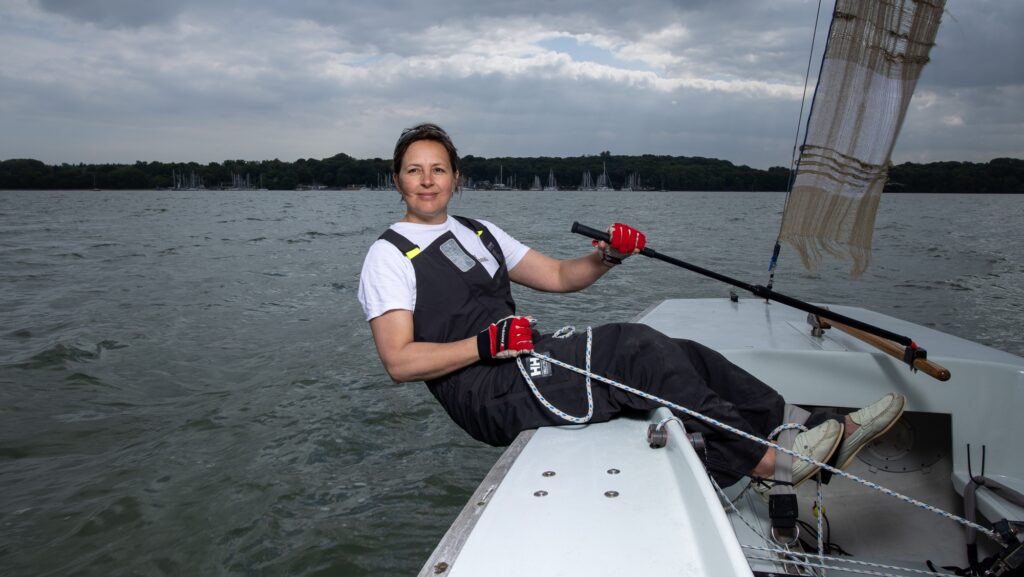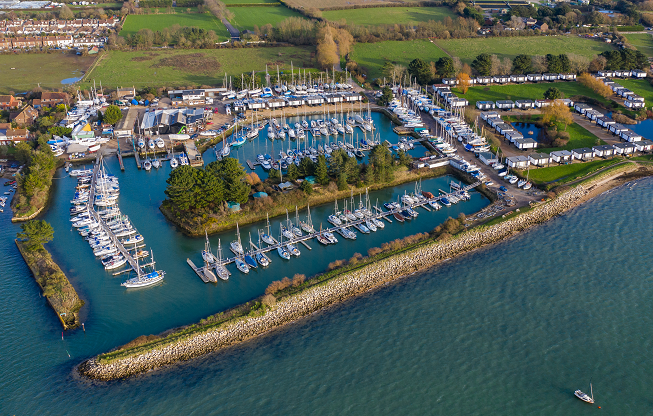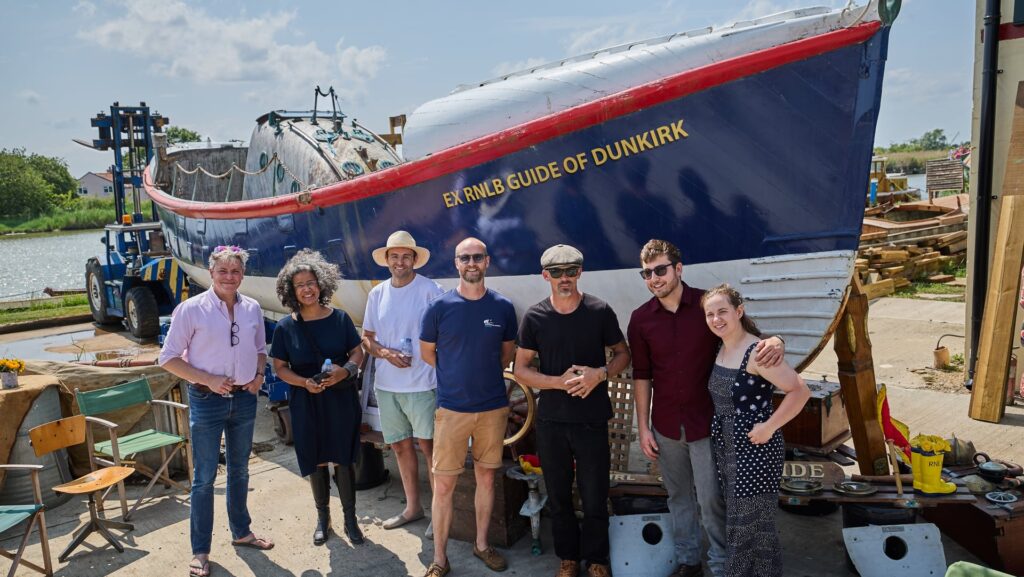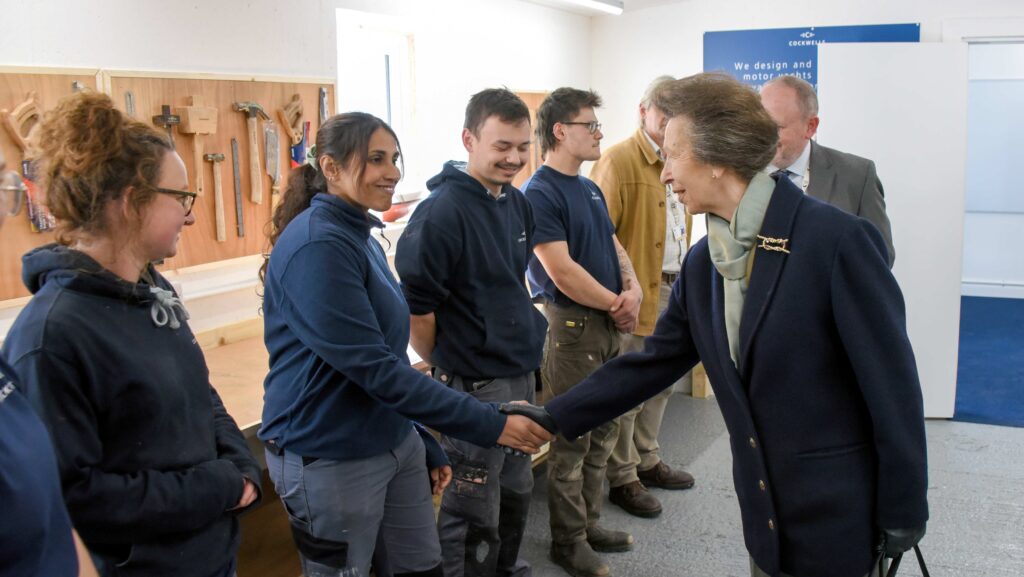Tom Marfleet is managing director of employee-owned Emsworth Yacht Harbour. Here, he casts a spotlight on the marine skills gap and the challenges facing the marine industry.
Walk into any small boatyard along the British coast and you’ll likely see rows of masts rising over a gravel hard, the smell of resin and salt in the air, the low murmur of radios and power tools. But listen more closely, and you’ll hear another, less cheerful rhythm — the ticking clock of a trade stretched thin. Not just the traditional boatbuilders, but the people who haul boats, step masts, carry out seasonal servicing, shoring and winter storage — the skilled hands who keep the yards working year-round — are becoming fewer, older and harder to replace.
Today, traditional boatbuilding and small to medium-sized yards across the UK are quietly edging toward a crisis in recruitment and retention. It’s not dramatic, and it’s not sudden — but it is happening.
“The recently released UK’s Modern Industrial Strategy places skills development at the heart of its pursuit of growth and productivity. But you won’t find marine leisure in the eight priority sectors it identifies,” says Darrell Bate, director of Maritime Training and Development, Marine Society & Sea Cadets. “So it will only be employer demand that will drive the recruitment the sector needs and their voice needs to be much louder.”
Skilled hands, disappearing fast
Much has been made of the decline in traditional wooden boatbuilding — and rightly so. The closure of the International Boatbuilding Training College (IBTC) Lowestoft was more than a local tragedy; it was a signal flare. The loss of its courses not only impacted would-be boatbuilders, but also deckhands, riggers and yard workers who gained broader practical skills there.
But focus too narrowly on boatbuilding itself and we miss a deeper story. The difficulty isn’t only in finding people who can steam-bend an oak rib or caulk a hull. It’s in finding people who can confidently operate a travel lift, safely shore a 12-ton motor cruiser, or step a mast in the rain and cold.
These are not low-skilled roles — they require physical intelligence, timing, practical risk awareness, and a commitment to safety and responsibility. And fewer and fewer people are learning them.
In many cases, the same person who sands the brightwork is also the one in the sling hoist or handling lines during a launch. As margins tighten, versatility becomes key — but that versatility is drying up as experienced staff retire and no one steps in to replace them.
With the closure of IBTC, only a handful of training centres remain — notably the Boat Building Academy in Lyme Regis and The Heritage Marine Foundation. But funding for learners, and particularly bursary places, are limited. Meanwhile, very few colleges or technical training providers offer hands-on yard-specific training. For example, a young person wanting to become a rigger has almost no formal path to do so.
Training falling through the gaps
This leaves small yards relying on informal, time-heavy, on-the-job training — often delivered by employees already stretched across several roles.
Notwithstanding this, on-the-job training has been the most successful route into gaining skills in the industry. Research from Women In Boat Building shows that the most common path to skill acquisition is through on-the-job training, more so than apprenticeships. Can we be doing more to recognise the impact of long-term skill acquisition, whether that is through formal training or informal, on-the-job training?

Belinda Joslin [left], founder of Women in Boat Building, adds: “We have a wonderful opportunity to pass on some of the incredible skills still held by the people working every day in this industry, and we need to focus on that talent transfer. We urgently need funding for the Boat Building Academy — so they can expand. We need funding for Heritage Marine Foundation so they can train marine engineering apprentices to the high level we need.
“The focus should be on excellence and pride in our heritage, and empowering the people on the yard floor to share their skills with trainees and the world. Young people are so far ahead of this industry in the way they are thinking about AI and its impact on their work and life.
We need to be dynamic and forward-thinking and make our world accessible — they’re looking for alternatives, and it’s on us to get on their radar, not waste time lamenting college closures.”
The demographic time bomb
The age profile of both boatbuilders and yard hands continues to skew older. In many boatyards, it’s not unusual for the most experienced staff to be approaching retirement — and for them to be the only ones who know how the yard crane actually works.
In our own yard at Emsworth, we have two really key staff members in our yard team. Both of them are brilliant, passionate, knowledgeable and skilled, but one is five years past retirement age and the other is in the back end of his career.
We have tried to bring new people into our yard but they can earn as much stacking shelves in the dry and warm in a supermarket and they haven’t lasted long in the often harsh weather conditions of a boatyard in winter nor with the physically demanding aspects of the job.
It’s not just skilled craft that’s being lost — it’s lived experience, health and safety instincts, local knowledge of towing, timber and tide tables. You can’t teach that in a PowerPoint presentation. It comes with time, and it comes with mentorship.
Beyond this, the trade has traditionally been dominated by white blokes. There is a huge opportunity to broaden the appeal of the sector to women and ethnic minorities. The focus should be on attracting individuals with passion for the crafts regardless of their route of entry into the industry.
Trained and gone: the frustrating skills drain
A growing challenge for boatbuilders and small marine businesses is not just recruiting trainees — it’s keeping them. Many invest significant time and resources into training young staff, only to see them leave after a couple of years for better-paid roles in adjacent industries.
Sectors such as construction, luxury interiors and composites manufacturing actively seek out marine-trained workers for their precision, problem solving and hands-on experience — and they often offer far higher wages and clearer career progression.
Jon White, general manager for the Yacht Harbour Association, says: “TYHA’s membership now extends across 29 countries, with the vast majority reporting similar concerns around the recruitment, training and retention of boatyard staff. It’s rare for meetings or discussions to conclude without mention of the sector’s aging workforce and the ongoing struggle to attract new talent.
“Anecdotal evidence suggests that younger generations are less likely to commit to a clear career path early on, and fewer are considering hands-on, practical roles. The UK’s current emphasis on university education — paired with limited promotion and funding for full apprenticeships — only exacerbates the issue.
“Is this challenge partly due to a lack of early exposure to our industry? Are we doing enough to effectively market marine careers to young people? What’s certain is that our industry must remain focused and proactive in building a skilled, experienced workforce capable of sustaining and supporting the future of leisure boating.”
The result is a vicious cycle: marine businesses become reluctant to invest in new trainees, knowing they might not stay long enough to justify the cost. As one yard manager puts it, “You train them, they get good — then they’re off to work in film or aerospace.”
Without structural support or retention incentives, the industry risks training workers not for its own future, but for everyone else’s.
Jasmin Klimcke from Heritage Marine Foundation adds: “As someone who started off as an apprentice ten years ago, I believe the secret to keeping an apprentice keen, involved and loyal is respect, responsibility, confidence and variety. One experienced mentor is all a young person needs to thrive in this industry, learning multiple skills, job responsibility and quality.
“Apart from mentorship or apprenticeship schemes, there isn’t another option for young people without the financial support to enter the marine industry. Sometimes these people are the most passionate and hard-working people who sit under the radar because they’re unaware of how to enter the industry.”
A web of pressures
This isn’t happening in a vacuum. Yards and workshops are being hit from multiple angles.
Upward wage pressure
As government legislation raises minimum wages — often a positive development — small businesses, especially seasonal ones, struggle to meet the increases while still charging competitive rates. Unlike mass manufacturers, they can’t offset those costs at scale. Many boatyards report being priced out of hiring trainees at all.
Increased health & safety and environmental compliance
Hauling boats is dangerous. Stepping masts is dangerous. Pressure-washing antifoul is hazardous and environmentally sensitive. The regulations around these activities have rightly grown stricter — but the cost of compliance now eats a significant chunk of small yard budgets. Disposal of hazardous waste, registration of lifting gear, environmental permits, scaffold certifications, risk assessments, PPE audits — all necessary, all time-consuming and all expensive.
Jonny Boys, managing director of Trafalgar Group, a boat services company based on the UK’s south coast, says: “Recruitment in the marine industry has always been a challenge, the talent pool is small, and not enough new people are coming into the sector. The situation is made harder by rising costs, increasing compliance burdens, and the fact that other industries can often offer better pay and more family-friendly working hours. Luckily for us, when people join they generally stay, but when growing new parts of the business the challenges become highlighted.”
Taxation and economic pressure
Yards, especially those on prime coastal land, face steep business rates, rising rents and high energy costs. Combined with increased tax burdens on small employers, many are unable to invest in apprenticeships or staff development. It becomes a downward spiral: no time to train, no money to train and no one available to step in even if you could.
What needs to change?

There is a very good boat yard apprentice programme and it has had success in larger boat yards in bigger boatbuilding firms. More support is needed for smaller yards and smaller businesses though.
Mobile training schemes could allow smaller yards to train new staff without losing productivity. A cross-business apprenticeship and training scheme that has pooled resources to support multiple learners over several yards could provide businesses and learners with the support they need.
In boatbuilding, we need more training providers. The loss of IBTC Portsmouth and IBTC Lowestoft is ruinous to the trade and in ten years time the lack of new talent coming into the industry will begin to bite.
Incentivise apprenticeships
Create bursaries or tax relief for small employers who take on apprentices or trainees. Fund short courses in essential yard operations — crane driving, slinging, rigging, shoring — through maritime colleges or adult education schemes.
Balance regulation with support
Government bodies should offer grants to help small yards meet environmental and H&S compliance, rather than just enforce it. Consider simplifying or consolidating certification schemes to reduce administrative burden.
Recognise and elevate the trade
Campaigns to raise the public profile of boatyard work — not just as a job, but as a skilled and vital craft profession — could help attract younger talent.
The industry has always been driven by individuals with a deep passion for boats and the water, often giving up better pay and conditions for the experience of working hands on with boats every day. We should never take these people for granted and they still exist. We need to find them and show them how rewarding a career in leisure marine can be.
Time to act
This is no longer just a question of preserving heritage — it’s about survival. Without new blood in boatbuilding and boatyard roles, Britain’s small yards face slow decline. Skills will be lost. Boats will sit idle. Waterfronts will fall silent.
The time for action is now. With collaborative action, targeted support, and a clear pathway for training and recruitment, we can safeguard not just an industry but a craft culture rooted deep in the maritime soul of this country.
Let’s not wait until the last travel lift operator retires or the last mast can’t be stepped. Let’s gather, plan and act — before it’s too late.
Tom Marfleet is managing director of Emsworth Yacht Harbour, an independent marina and boat yard on Chichester Harbour. With 21 years’ experience he is passionate about saving the skills and people that keep the industry going.
The post Is traditional boatbuilding sleepwalking into a retention and marine skills crisis? appeared first on Marine Industry News.




Leave a Reply